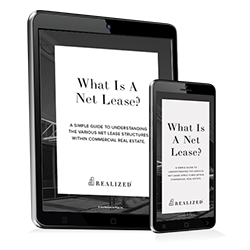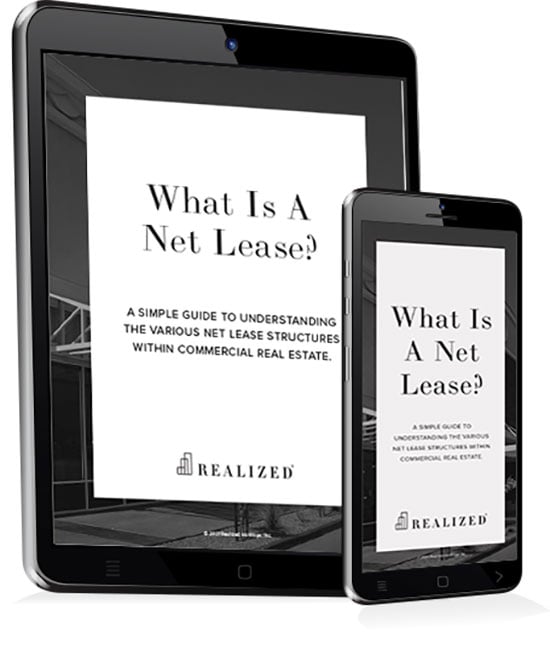
A single-tenant net lease property is one which, as the name implies, is fully leased to one tenant on a net lease basis. The lease is often a triple net lease , meaning the tenant is fully responsible for all property operating expenses. A single-tenant net lease (STNL) offers investors the opportunity to own a (typically) freestanding property occupied by a single tenant. New leases for these properties are often longer-term (10 to 25 years) and tenants frequently include household-name businesses such as Walgreens, McDonald’s or Starbucks. In addition, net lease properties may provide the following investment benefits:
- Stable and Predictable Cash Flow
For many investors, the most attractive quality of investing in a single-tenant net lease property is its relative stability and passive income nature. With new leases commonly spanning at least 10 years, and upwards of 25 years, a STNL property offers predictable long-term cash flow. Since rental rates are defined in the lease agreement and the tenant is responsible for all, or majority of, operating expenses, future cash flows to the investor are more predictable than compared to other real estate investments. Further, because of the contractual lease term, this cash flow is not as vulnerable to tenant turnover or fluctuations in market lease rates when compared to properties with shorter-term lease agreements.
- Low Degree of Landlord Responsibility
Most single-tenant net-lease structures are tailored to give the landlord minimal responsibilities. STNL tenants are generally responsible for property operating expenses and often pay these expenses directly. For example, property tax bills may be sent directly to, and paid directly by the tenant, thereby relieving the landlord of even having administrative functions. Also, because it is usually in the tenant’s best interest to keep the property in good condition, and up to “corporate standards”, the investor’s landlord responsibilities may be substantially less compared to other investment properties. In many cases, a STNL investor’s only duty is to collect their monthly rent!
- “Name-Brand” Credit
Single-tenant net-lease tenants may include publicly traded and/or investment-grade companies such as Walmart or FedEx. The public nature of these companies and availability of third-party credit ratings make it easier for an investor to assess the financial strength of a tenant than compared to dealing with an individual or local tenant . A STNL investment property leased to a tenant with strong credit may provide a higher degree of security in receiving rental payments. Investors should take caution, however, when reviewing STNL investments of which entity is actually guaranteeing rental payments, as the lease may actually be with a subsidiary or franchisee.
- Lower-Entry Price Point
Prices for single-tenant lease properties can start as low as $500,000, and a large volume of properties in this sector is priced under $5 million. With leverage, an investor with as little as $200,000 of equity may be able to acquire a net-leased property outright.
Property Type Median Asking Price 2016* Dollar Store $1,362,000 Auto Parts < $1,800,000 Quick Service Restaurant $1,830,000 Medical $3,400,000 Bank (Ground Lease, Bank of America) $6,024,000 Drug Store (Walgreens) $6,117,000 Big Box $9,000,000 Larger net-lease properties such as big-box retailers Home Depot and Walmart or industrial distribution centers can trade at substantially higher prices. For investors interested in investing in these larger assets, but without the financial resources to do so, investment structures such as a Delaware Statutory Trust (DST) may be a viable option.
- Attractive Financing Terms and Structures (depending on tenant credit and lease terms)
In more traditional real estate sectors, loans are written against the value of the property. In a single-tenant net lease, especially a bondable lease with a long remaining lease term, the investment is backed by the tenant’s credit as much, or even more so, than the underlying real estate, which may provide for financing options not typically available to other property investments such as credit tenant lease (CTL) financing .
- Relatively Higher Liquidity for a Real Estate Asset
Because of the benefits described herein, single-tenant net-leased properties appeal to a variety of real estate investors ranging from large institutions to individual investors, fostering a large investor universe.
Like any investment, STNL properties do have their risks (see our blog on the risks of NNN investments ). However, STNL properties can be an appealing option for many real estate investors. Long-term lease periods and fixed rent schedules have to potential to provide a steady source of income without the hassle of day-to-day property management responsibilities. Visit our Marketplace to browse a selection of STNL properties and other management-free investment options.



